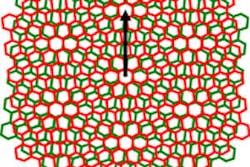A multinational team of researchers has discovered that two layers of graphene, one rotated at a specific angle relative to the other, can be used as a material that, when irradiated by laser light at the proper wavelength, exhibits Stokes and anti-Stokes emissions.1 Because the anti-Stokes emission has a shorter wavelength than that of the laser light, it carries energy away from the two graphene layers, thus cooling them.
In the graphene stack, called twisted bi-layer graphene, one sheet is rotated by 11.3° with respect to the other. The team includes members from ETH Zürich (Zürich, Switzerland), Universidade Federal de Minas Gerais (Belo Horizonte, Brazil), University of Manchester (Manchester, England), and University of Basel (Basel, Switzerland).
"When we make graphene flakes using sticky tape, some flakes have edges which are straight, giving an indication of the direction the atoms are oriented in," says Nick Clark, one of the University of Manchester researchers. "We identify two such flakes, and then line them up so that the straight edges are at a fixed angle. The angle we need to produce depends on the color of the laser light we will be using."
"As you might have experienced, if a computer chips runs fast, it gets very hot," says Aravind Vijayaraghavan, who heads the Nano-functional Materials Group at the University of Manchester. "This will also be true for future computer chips that might be made with graphene. If it is possible to cool down the chip, then it can run faster. Currently, people use air conditioning, cold water, or even liquid nitrogen to keep their computers cool. A future graphene computer might be cooled by shining a laser on it."
Source: http://www.manchester.ac.uk/discover/news/article/?id=12820
REFERENCE:
1. Ado Jorio et al., Nano Letters (2014); doi: 10.1021/nl502412g

